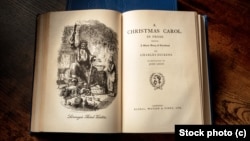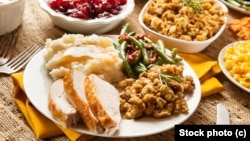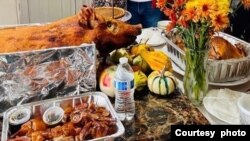All About America explores American culture, politics, trends, history, ideals and places of interest.
The United States broke free from Britain more than two centuries ago — except, maybe, when it comes to the traditional Christmas dinner.
"The way we structure that meal is probably our most British culinary experience on the American calendar," says Ben Davison, a chef, historian and lecturer at Loyola University New Orleans. "The way we envision a perfect Christmas dinner, the turkey and the prime rib — those are very classic British festive foods. … Even the way we structure the side items, potatoes and all that, these are all very much the British table."
Eggnog is a British concoction. And American efforts to recreate a traditional British Christmas pudding, made with dried fruit, rum and molasses, resulted in the modern fruitcake, according to Davison.
Some historians maintain that it was Charles Dickens' classic novella "A Christmas Carol" that permanently influenced what Americans put on their holiday tables. Food scenes from the British author's story reference turkey and cranberries, which are often served at Christmas today.
"That's a lot to do with the power of British aristocratic culture still percolating, very subtly, in well-to-do America," Davison says.
But immigrant families are adding their own touch to the British-inspired meal. Food writer and cookbook author Cathy Erway's half-Chinese family creates its own traditions.
"I've always experienced, growing up, Christmas as sort of a two-part holiday when it comes to foods. Where the night before Christmas ... is an elaborate multicourse Chinese meal, and then Christmas night supper is always a really American European dinner, which usually involves big roasts of some sort," Erway says.
As a food writer, Erway says she's interested in learning about new holiday conventions beyond European traditions that people are forging.
"It should be whatever your family likes and whatever traditions you create that makes sense to you, and from your culture, from your upbringing," Erway says. "I don't really think that people need to adhere to things just because they heard about it in a novel by Charles Dickens."
For Jenny Nguyen's Vietnamese American family, a holiday meal usually consists of roast pig, fried rice and a pudding-like dessert called chè. The meal does not necessarily include turkey or any other traditional holiday foods.
"We tried to do it in the past, and we do love those dishes. We have done those for a few years, but we always just gravitate back to our traditional dishes, because it's not something that we make on a daily basis," says the Virginia dental student. "We don't have roast pig on a regular basis or fried rice on a regular basis."
RJ Mosuela's parents immigrated from the Philippines before he was born. Their holiday table is a mashup of foods from their native and adopted countries.
"We'll have the traditional Thanksgiving/Christmas stuff like your turkey, your ham, mashed potatoes, stuff like that," says Mosuela, a health care recruiter who lives in Virginia. "But they'll also add a wide variety of Filipino dishes, including noodle dishes. … The noodle is supposed to represent long life, so a big dish is called pancit. You'll see that a lot at any Filipino event."
Davison is Jewish, but says he generally ends up cooking Christmas dinner, which usually includes prime rib. And although immigrant families might add their twists, he expects certain mainstay foods to endure.
"I personally think the Christmas meal will probably keep looking the same for a long time," he says, "as long as you have the same kind of agricultural abundance in the culture."







